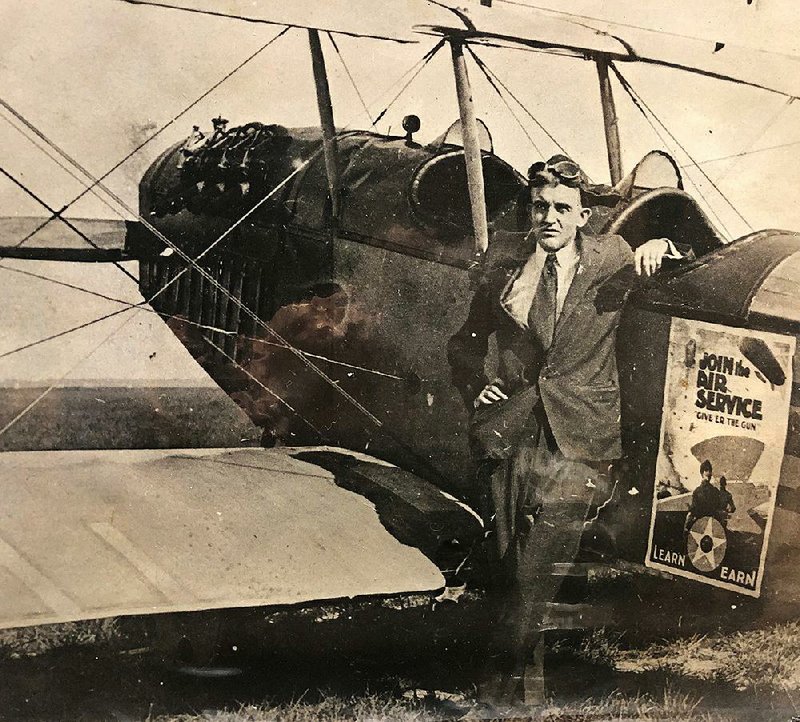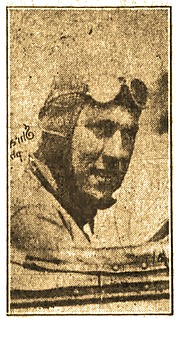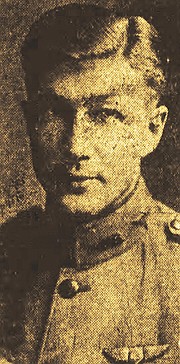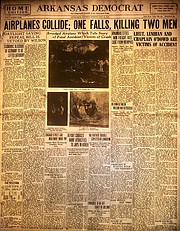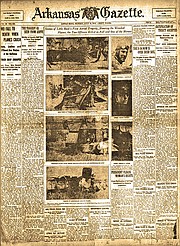On the morning of Saturday, July 12, 1919, the front page of the Arkansas Gazette gave readers a cheerful heads-up about an exciting performance to watch for in the sky above Little Rock -- an advertising stunt no one would want to miss.
It turned into something no one wanted to see.
"Birdmen" from Eberts Field in Lonoke were to fly over the city between 8:30 and 9 a.m., doing stunts and tossing handbills to promote a minstrel show by Camp Pike officers coming that Monday. It was the daring young Army pilots' first aerial visit to the city in several weeks, since Lts. C. Eugene Johnson and Vern U. Ayers had performed a wild stunt -- buzzing below the Free Bridge in their biplane before making a sharp climb to about 50 feet, whereupon Johnson dove from biplane into the Arkansas River.
The Gazette explained:
This will be the first appearance of any planes over Little Rock since the recent order was issued by Maj. Arnold Krogstadt, commandant of the field, forbidding further flights until a safe landing place is provided.
City boosters on both sides of the river had been scouting sites for a landing strip, but none had so far been acceptable.
Thousands of spectators were watching on the ground July 12 while three aircraft circled and zoomed above the city, scattering the circulars. About 10 a.m., two planes collided, a disaster described with eyewitness details and an unusual number of photographs in ensuing editions of the Gazette and Arkansas Democrat.
Chaplain Denis O'Dowd of Camp Pike and Lt. Thomas J. Lenihan were killed when their open-cockpit biplane fell to earth. The plane hit nose-first in the lawn of resident H.A. Bowman's home at 21st and Wolfe streets.
Witnesses said O'Dowd appeared to have died instantly, but Lenihan was alive -- unconscious but breathing -- while he was being loaded into a Healy & Roth ambulance. Varied accounts said he died in the ambulance or at the hospital.
The second smashed-up biplane, piloted by Lt. Robert E. Ryan, made a miraculous landing, with pilot and passenger walking (or rather, running) away uninjured.
Gazette night editor Clyde Dew was a passenger in the third plane and wrote about his experience for the next day's newspaper.
Besides Lenihan and Ryan, the Eberts Field pilots included Ayers, who was the most famous of the pilots (and had helped Johnson do his amazing dive into the river). Each was to take a member of the Camp Pike Morale Section on the jaunt, since they were sponsoring the minstrel show. O'Dowd went up with Lenihan, and Lt. Carl E. Stockholm rode with Ryan.
At the last minute, the third Camp Pike officer begged off, and Eberts Field commander Maj. Arnold Krogstadt invited Dew to take his place, because Dew's story about Ayers and Johnson's recent escapade had pleased all the pilots.
Dew was supposed to be Lenihan's passenger, but Ayers asked permission to take him instead.
BIRD'S-EYE WITNESS
Dew wrote that Lenihan was leading the little squadron in a close formation while dropping circulars over town. Lenihan was in the center with Ryan at his left and Ayers at his right and little above.
Lenihan started upward and, the Gazette suggested, possibly hit an air pocket, which would explain why he didn't rise clear of Ryan's wing.
Dew missed seeing the collision -- because his pilot, Ayers, saw it coming and took evasive action. Dew had noticed Ryan banking to make a left turn and assumed they were all going to make another pass over the city, so he braced himself for the expected sinking of the left wing of the plane.
"Instead, the plane banked abruptly right and shot downward and away from the other machines," he wrote.
The momentum hurled Dew against one side of what he termed his "passenger pit":
I didn't know then that the cool young flier's keen eye had seen the crash coming, that his fast-working faculties had perceived the danger that his own ship might be involved in a three-plane crash and that he was diving out of the danger zone as rapidly as he could. Instead I felt a vague feeling of annoyance at this unexpected maneuver of Lieutenant Ayers.
Dew estimated the other planes were about 75 feet ahead when Ayers cut away.
I was thrown against the side of the pit and several seconds elapsed before I regained an upright position in the seat. When I looked again for the other two planes they were nowhere in sight.
Until he looked down.
Nearly every person who followed the world war closely has seen pictures of battles in the air with the vanquished plane tumbling to earth. There was the picture reproduced in all its dreadful reality before my eyes. ... This was no "stunt," it was the grim reality of two brave men going to their deaths.
He watched as Lenihan fought for control and lost.
He also saw Ryan's plane, crippled and down low but leveling out in a way that gave him hope those men had a chance.
SAFE LANDING
With a broken wing, torn fuselage and crushed tail, Lts. Ryan and Stockholm managed a bumpy landing in an open field beside Fourche Creek a quarter of a mile away from the crash site. Before their propeller stopped, they were unbuckling and then running.
Fifteen minutes too late, they arrived to find the ambulances gone and a crowd of about a thousand people ready to tell them their friends were dead.
Meanwhile, Ayers was speeding with Dew to the nearest place he might land, Camp Pike north of North Little Rock. The landing field at Camp Pike was so lumpen and dangerous Krogstadt had forbidden his men to use it. But Dew said obeying orders was not on Ayers' mind at the moment.
Ayers made the difficult landing in a breeze, and they ran to headquarters where they were granted a car and driver. Dew wrote:
"As quick as you can, private, and to hell with the speed laws," said Ayers.
The driver obeyed implicitly. A wild dash to Little Rock, picking up Patrolman Dick Cross, who consented to go along to prevent the car being stopped by other officers and another dash to the scene of the splintered, twisted wreck of poor Lenihan's plane.
There we found Lieutenant Ryan, who had escaped death by a miracle after a fall of more than a quarter mile in his smashed up plane.
He's of the stuff that real aviators are made of, that boy. He was pale and shaken and stricken with grief. But his thoughts were all of Lenihan. ...
"It's terrible. Poor old Lennie," he told Ayers. "But I don't see how I could have helped it, before God, I don't see [how] I could have helped him."
FUNERALS
O'Dowd was from Cappan, N.Y. He had recently been promoted to captain when he was transferred from the Depot Brigade at Camp Pike to the Morale Section. Unmarried, he was 35.
Lenihan was an Ohio native who grew up in San Francisco. He had volunteered for the Army a few days after the United States entered the world war and, the Gazette said, was one of the first Army pilots commissioned. Unmarried, he was 26.
Dew wrote that he knew Lenihan and admired him as a "modest, quiet, unassuming sort, always willing to discuss fliers and flying but never saying much about himself."
On July 15, two planes from Eberts Field flew over Little Rock for an hour with black ribbons dangling from their cockpits. They circled the Healy & Roth funeral home and then flew slowly over a cortege bearing Lenihan's body to the Missouri Pacific railway station, where the body went by train to Lonoke. From Lonoke, 1st Lt. Smiley G. Ellis flew it to Lenihan's home in San Francisco.
Stockholm accompanied the chaplain's body to his home in New York. They had been roommates.
In December, Krogstadt, Ryan, the diving daredevil Johnson and other Eberts Field pilots performed in an aerial circus over Jonesboro for the dedication of a landing field in Lenihan's honor.
Johnson climbed out of his cockpit, walked on the wings, dangled from the landing gear and crawled back into his seat.
FATES
When Ryan left the Army he became a newsman. He was city editor of the San Jose Mercury in the 1940s and later a reporter for the San Francisco Chronicle. He was 62 when he died in 1958; his obituary in the San Mateo [Calif.] Times claimed, somewhat improbably, "He was credited with being the first airman ever to land a plane successfully after an aerial collision. The incident occurred over Little Rock, Ark., July 12, 1919."
Dew worked for the Gazette until he was an old man. In Roy Reed's Looking Back at the Arkansas Gazette: An Oral History, former staff members describe a "particular" old Michigander who would fight anybody. Farris Wood said Dew was called "Count" or "The Count" for his habit of using his fingers while calculating the size of headlines.
Count Dew smoked a corncob pipe, and when concentrating on copy would decide the pipe had gone out and tap its ashes into a wastebasket, setting the trash on fire. Farris said kind women in the office would distract him and carry his smoking can out to dispose of it while he wasn't looking. "That happened almost every night," Farris said.
AYRES CASTLE
Ayres was 28 when he retired from the Army Air Service in December 1919. The Gazette wished him well in an article on the front page.
He was a barnstormer and stunt performer in the 1920s and a bush pilot in Alaska. His career in aviation carried him finally to San Pedro, Calif., where he flew charters for an air ferry service that conveyed starlets and movie moguls to Catalina Island.
The 1940 U.S. Census found him married to his former stunt-flying partner, a wing walker named Miss Elfleda; they had a 10-year-old daughter.
He taught high school welding and built "Ayres Castle," a Scottish-fortress-inspired mansion in the 3400 block of San Pedro's Peck Avenue. It had 8-inch-thick floors, hidden doors, secret rooms, small cannons.
He became "a roaring eccentric," according to an article in the December 2010 San Pedro Today magazine. Valerie Electra Smith-Griffin wrote that Ayres' welding students helped him construct a maze of tunnels under his Castle's interior and garden.
The King of the Castle lived simply, with his pet raccoon, in a back room he called the Dungeon, she wrote. He ate Dinty Moore beef stew and Oreo cookies.
He died in 1973 and is buried at Green Hills Memorial Park in Los Angeles.
Supposedly, tenants of the Castle see his ghost crawling through tunnels or peering out from below a strategically placed manhole cover. One tenant described his apparition as thin and bearded -- like Willie Nelson.
The Old News column is based on 100-year-old stories in the archives of the Arkansas Democrat-Gazette and appears Mondays in Style.
ActiveStyle on 07/15/2019
